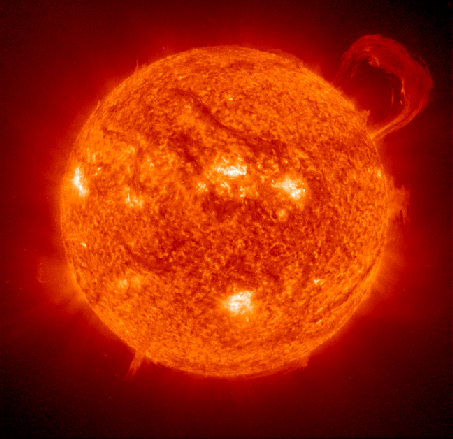 |
| Our Sun photographed by the European SOHO satellite (Note the giant prominence). Photo: ESA/NASA |
Our Sun is an ordinary star, composed mainly of hydrogen and helium. It has a diameter 109 times greater than the Earth's and a mass of over 300,000 times the Earth's. The surface of the Sun has a temperature of about 6,000 degrees Celsius. It's core (the inner 25% of the Sun) is extremely hot, having a temperature of about 15 million degrees. The Sun shines by a process of nuclear fusion, that is, within the extremely hot core of the Sun, four hydrogen atoms combine, or fuse, to form a single helium atom, plus a little bit of energy. So many atoms are, in fact, fused together that the total amount of energy released is substantial. This energy is transported to the surface by radiative and convective processes. The enormous weight of the Sun's material is balanced by the internal gas pressures. This balance of forces is called hydrostatic equilibrium. It is what keeps the Sun in a stable spherical shape. The Sun has been shining steadily for about 4,600 million years, and there is enough mass to continue for a further 5,000 million years.
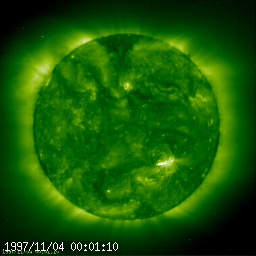 |
| The Sun in the extreme Ultra-violet. A Solar Flare can be seen to erupt and eject material into space. This material eventually reached the Earth and interacted with it's magnetic field. Photo: ESA/NASA |
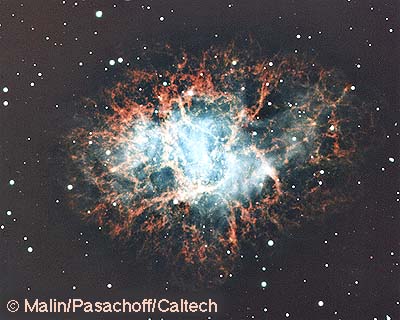 |
| The Crab Nebula in Taurus. Chinese astronomers reported seeing this star explode in 1054 AD. Photo: David Malin (AAO) |
Stars many times more massive than the Sun, end their lives violently. When their helium cores collapse, they continue the process of nuclear fusion, producing yet heavier elements. Eventually, however, this process becomes unsustainable, and the temperatures become so great that when the core collapses a last time, it blows the star apart. This enormous explosion is called a supernova. In just one second, more light and energy is released than the entire galaxy combined. As a result, the core of the star becomes so compressed that the electrons and protons combine to form neutrons, thus producing a neutron star. These stars are extremely dense and small, typically just 20km in diameter. If they happen to be spinning in the direction of the Earth, then they may be observed as pulsars. If stars even more massive than these explode, then their cores become so compressed and dense that the atoms themselves cannot support the enormous weight of material pressing down. Gravity takes over and continues compressing the cores, until a black hole is formed. Here, gravity is so strong that nothing, not even light, can escape the star. The star can be said to have exited our universe.
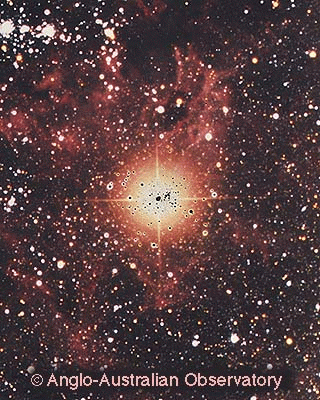 |
| The Supernova 1987A, which exploded in the Large Magellanic Cloud 169,000 light years distant. Thankfully, supernova this far are safe to view. Photo: David Malin (AAO) |
If a supernova occurred within a few light years of the Earth, then the resulting release of radiation and stellar material, would be sufficient to destroy all life upon the Earth. Fortunately, for the present, there are no massive stars close enough to the Earth, to cause us concern. However, as the Sun orbits the centre of our Galaxy, it will at times enter regions of greater stellar density. This may put the Earth at greater risk of being near a supernova. A recent study has found that mass extinctions in the past, correlate closely with passages of the Sun through the dense spiral arms of the Milky Way Galaxy.
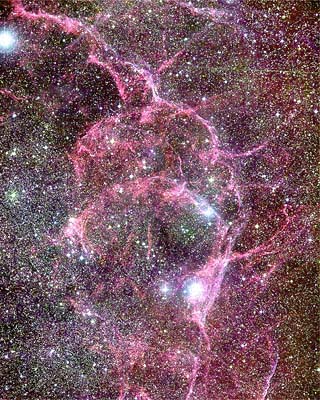 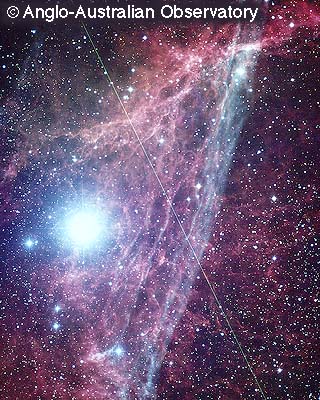 |
| The Supernova Remnant in the constellation of Vela. Photos: David Malin (AAO) |